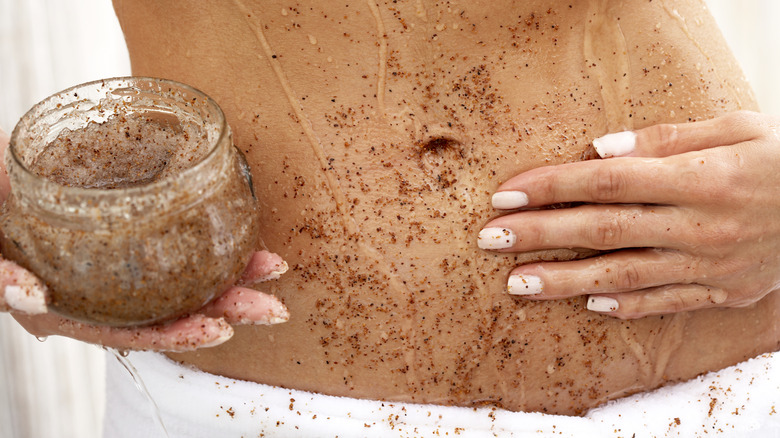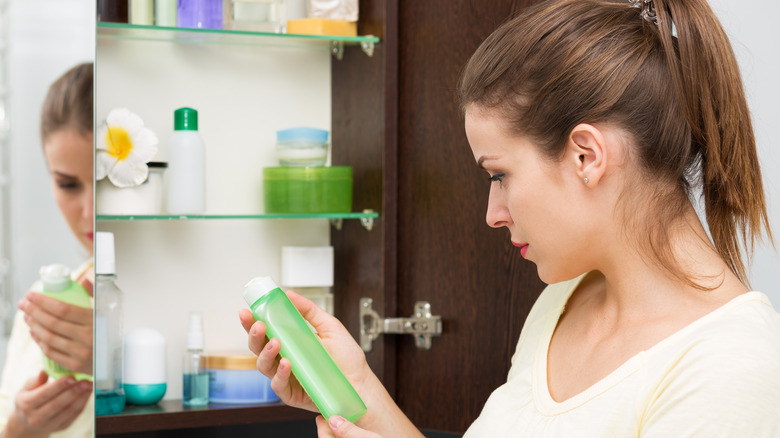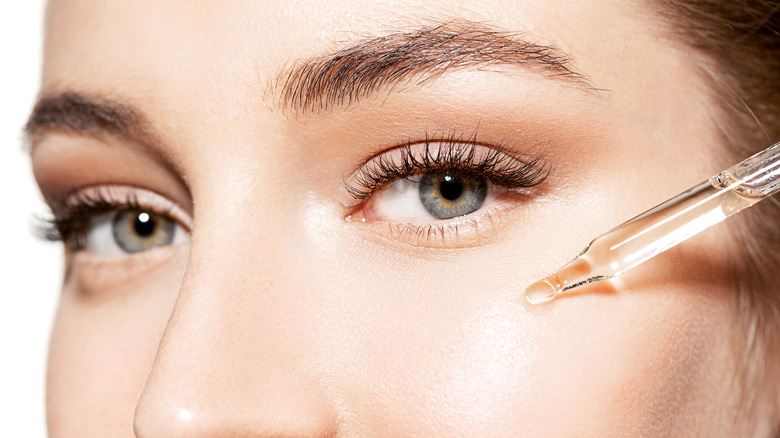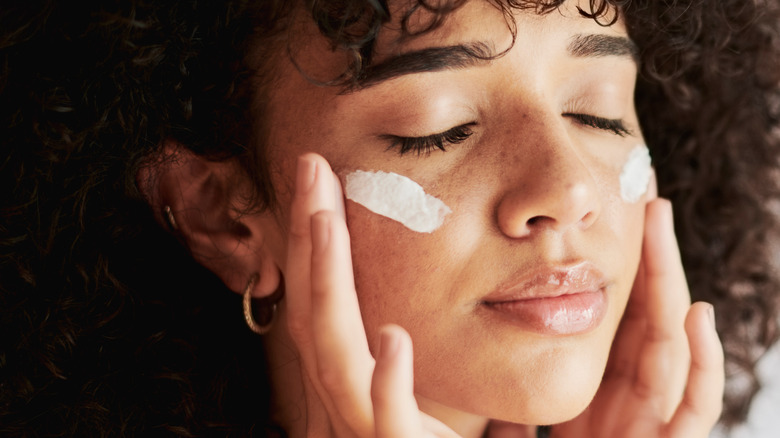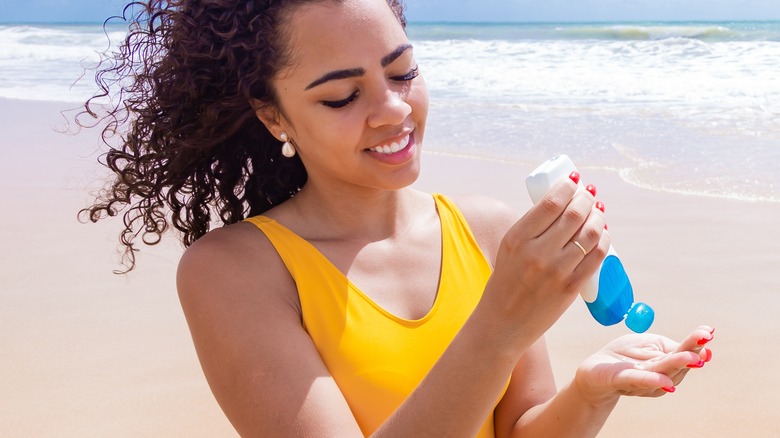Faced With Pilling Sunscreen? Here's Why It May Be Happening
Even if you don't have signs of sun damage or aging as a result of spending time outdoors, you likely know the importance of wearing the right sunscreen for your skin. By applying it before you go outside, you can limit the impact of the sun's ultraviolet (UV) rays on your body. In addition to preventing premature skin aging, sunscreen can help you reduce your risk of developing skin cancers. However, this form of sun protection comes in various formulas, and applying it isn't always easy. To make matters worse, some sunscreen products can pill once on your skin, making them uncomfortable to wear throughout the day.
Pilling can result in clumps or residue that sits on top of the skin, rather than being absorbed. If your favorite sunscreen pills upon application, you might be discouraged from wearing it regularly. However, skipping this important skincare step comes with big consequences. By failing to protect your skin before sun exposure, you can experience everything from reddening to sunburns. You also raise your risk of developing skin cancer, as well as signs of aging, such as sun spots and wrinkles.
If you don't want to give up your favorite sunscreen but you're tired of dealing with pilling, understanding the causes of it can help you address the problem. Overapplication, poor quality, and not waiting for other skincare products to dry can all be causes of pilling.
You aren't exfoliating your skin
If you don't exfoliate your skin regularly, you may not be getting the most out of your skincare products. By failing to exfoliate, you are allowing dead skin cells to remain on the surface of your skin. While there aren't any dire consequences for doing so, exfoliation has several benefits. In addition to helping you unclog your pores, it can improve the overall appearance of your skin. Furthermore, removing the layer of dead skin can give topical skincare products the chance to be absorbed more effectively — including your sunscreen.
If you begin exfoliating regularly, you may even be able to boost your skin's collagen production. By doing so, you can improve the elasticity of your skin, which can give you a more youthful appearance — no more fine lines or sagging.
To exfoliate, all you need is a scrub and a bathing tool, such as a loofah or exfoliation mitt. There are several different types of exfoliation scrubs, but if you're in a pinch, you can use items in your kitchen cabinet. Coffee grounds and even sugar can be used to exfoliate your skin. Skip the lemons when exfoliating, though. Depending on your skin type, you might only need to exfoliate a few times per week in order to begin seeing the benefits. In the least, you can be sure your sunscreen is giving you maximum protection from harmful UV rays.
You aren't applying your skincare products in the correct order
If you're already well versed in all things skincare, you might know the importance of applying your products in the correct order. However, this rule of thumb also applies to sunscreen — this means that if you're noticing pilling, your order of application may be out of sorts.
To begin, take a look at your products and sort them according to their consistency. Ideally, thick and oily items should be used last in order to give thinner formulas a chance to be absorbed by your skin. "This means essences and toners go on first since they're the lightest, followed by fluid-like serums, then lotions and creams," Colorescience's Patricia Boland told IPSY. "Sunscreen should always be the last step in your skincare routine prior to applying makeup."
Thinner products have smaller molecules, while thicker ones consist of larger molecules. When thicker formulas are applied to your skin at the beginning, they prevent the thin ones from being absorbed effectively. This ultimately increases the chances of products, such as sunscreen, pilling on top of your skin. Remember, some ingredients may simply not mesh well together after application. A quick internet search of the active ingredients in your skincare products can help you spot any poor matches that could be contributing to sunscreen pilling.
You aren't waiting for your skincare products to dry
If you're in a rush, you might immediately throw on your skincare products one after the other without even thinking about it. You may assume that all of the ingredients are going to work if you've applied them in the correct order. However, this isn't always the case if you didn't wait for them to dry in between applications. Furthermore, it could be the reason why you always experience pilling after applying sunscreen. "If you put a mineral sunscreen on wet skin, it doesn't go on," board-certified dermatologist Dr. Shirley Chi told Well+Good. "If you're applying it to wet skin, then that's going to affect the absorption of the chemical sunscreen."
As it turns out, it takes at least 30 seconds for more skincare products to absorb into your skin. However, this can vary depending on the consistency of the formula. If you notice any wetness on your skin as you're going to apply the next product, wait it out. You can use your fingers to touch a questionable area and determine if it's ready for more — if you still feel dampness, your last product has not fully absorbed. When time permits, give each product up to 10 minutes to work its magic. In the end, you'll face fewer chances of any of your skincare items pilling.
You're applying too much sunscreen
If your skin tends to burn under the sun after a short period of time, you may be inclined to slather on an ample amount of sunscreen. However, it is possible to overdo it, and this may be causing your sunscreen to pill. "A heavy application leaves a lot of product on the skin that likely can't be absorbed," Colorescience's Patricia Boland told IPSY.
Generally speaking, the Skin Cancer Foundation notes that most people don't apply enough sunscreen, but the potential to overapply does exist. As a rule of thumb, try to cover every exposed area of your body with about two tablespoons of sunscreen — the equivalent of a shot glass. On your face, you can get by with a nickel-sized drop of it. If you're using a spray formula, continue to apply it on your body until it appears evenly sheen.
While it's important to avoid overapplication — especially if you're dealing with pilling — it's just as critical to re-apply your sunscreen throughout the day. Regardless of formulation, it should be used every two hours while you're outdoors. However, you might need to re-apply it more frequently if your skin is exposed to water. This means that if you plan to hit the beach or pool, you'll want to keep your sunscreen on hand for re-application throughout the day. The same goes if you plan on engaging in a sweat session.
You're unaware of your sunscreen's formula
Some sun protection is better than no sun protection, but if you're dealing with pilling, the formula of your sunscreen may be the cause. Just like other types of skincare products, sunscreen comes in various forms and consists of different ingredients. While the active ingredients may be the same, the other additives might be to blame for pilling. If you're noticing this problem, reconsider your formula. "Try avoiding sunscreens that have a lot of silicone," board-certified dermatologist Dr. Sheilagh Maguiness told IPSY. "If you continue to experience pilling from mineral-based sunscreens, try a chemical formula instead."
Aside from silicone, other ingredients that are known for pilling include xanthan gum, mica, iron oxide, and other mineral blockers. If you don't want to give up the sunscreen you're using but aim to avoid pilling, try not to rub it onto your skin. Instead, pat it onto the areas that need coverage for adequate protection.
At the end of the day, sunscreen is essential to safely spending time outdoors. Wearing it not only prevents nasty sunburns, but reduces your chances of developing serious health problems, such as skin cancer. Pilling doesn't have to stop you from protecting yourself from the sun, and these tips can help you reduce the chances of it occurring. In turn, you can feel confident that your skin looks flawless when it comes time to show it off in the warm weather.

